Football has long been dubbed the beautiful game, partly due to its entertaining and unpredictable nature.
However, this summer, for one nation, football will represent so much more.
As the invasion of Ukraine continues, Euro 2024 presents an opportunity for escapism from the harsh reality of war and a platform to express the national identity of the Blue and Yellow.
Ukraine midfielder Volodymyr Brazhko recently echoed this sentiment, stating that “the Euros will help the world not forget about Ukraine.”
The unity and character of the Ukraine squad have been evident throughout their journey to eventual qualification.
The road to Germany for Serhiy Rebrov’s side was a difficult one from the onset – pitted in a qualifying group against England and current holders Italy as well as the disadvantage of not being able to play on home soil.
However, Ukraine came within a whisker of automatic qualification, succumbing to third place in the group due to the Azzurri’s superior goal difference.
Consequently, Ukraine had to contend with the play-offs, and late comeback victories over Bosnia and Herzegovina, followed by Iceland, booked the Eastern Europeans’ place in their fourth consecutive European Championships.
Ukraine will look to see if they can at least replicate their quarter-final finish last time out, but they will first need to negotiate through Group E, which also includes Belgium, Romania, and Slovakia.
This tactical analysis and scout report will explore Ukraine’s chances in Germany, providing a breakdown of their tactics and an analysis of the talent at Rebrov’s disposal.
Predicted starting XI
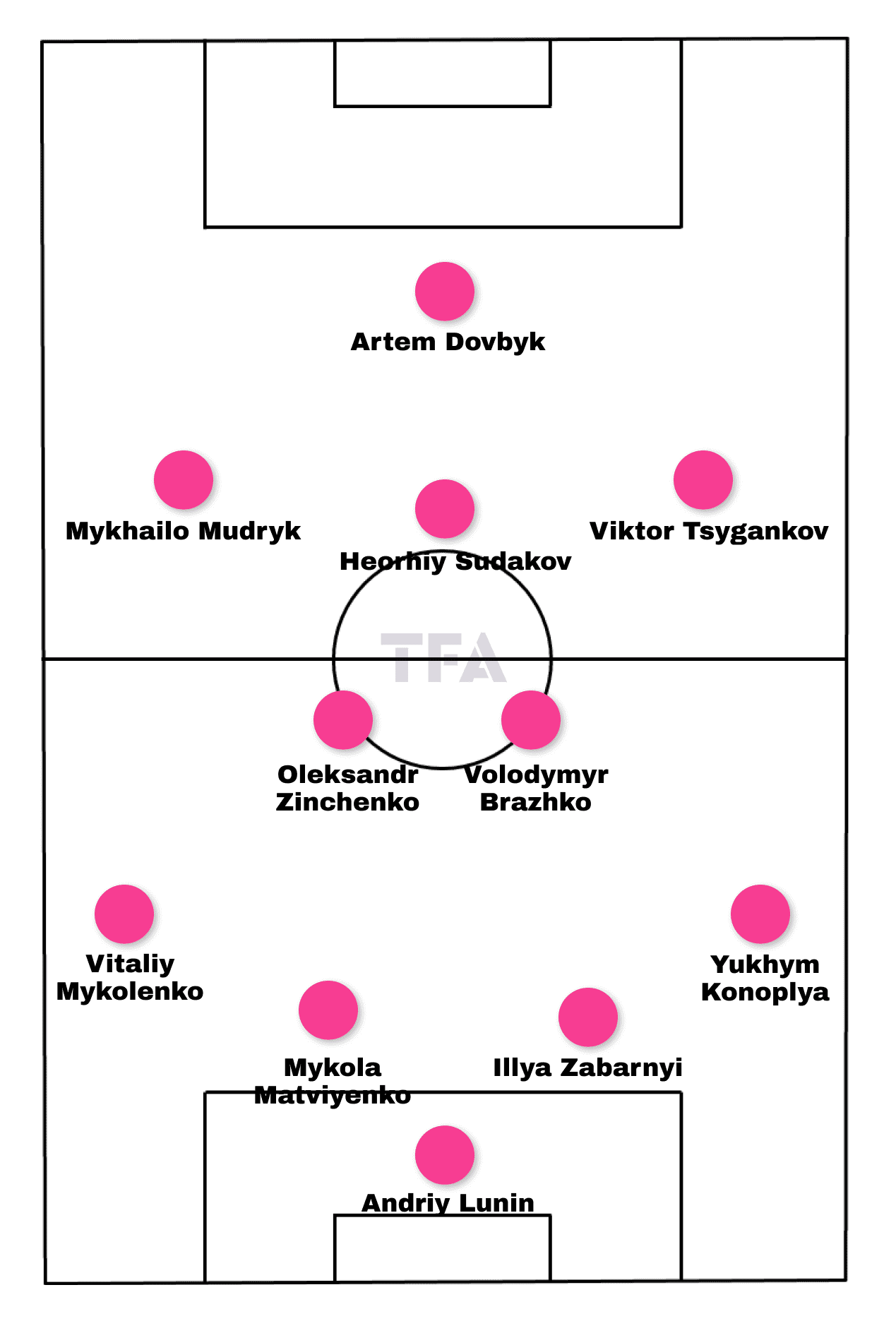
Ukraine typically adopts a 4-2-3-1 formation and has opted for this shape throughout the qualifying stages.
However, they have been flexible in their line-up and have been known to experiment with 4-1-4-1 and 4-4-1-1 formations.
It will likely be a battle for the goalkeeper gloves in Rebrov’s side with Benfica’s Anatoliy Trubin and Real Madrid’s Andriy Lunin vying for the role.
We have opted for the latter, though, due to Lunin’s exceptional season as the Galáctico’s reclaimed the La Liga title.
Lunin has stepped up in Thibaut Courtois’ absence this campaign and has helped oversee the tightest defence in Spain’s top tier so don’t be too surprised to see him starting in goal.
The back four comprises some familiar names for Premier League fans, with Everton’s Vitaliy Mykolenko at left-back and Bournemouth’s Illya Zabarnyi on the right side of the centre-back pairing with Shakhtar Donetsk’s Mykola Matviyenko.
Completing the defensive line is another Shakhtar starter at right-back, Yukhym Konoplya.
There are question marks about whether Mykolenko will be fit in time for the Euros, given he has been ruled out for the remainder of the Toffees campaign, but if he can pass the fitness test, expect him to start.
It is likely that occupying the double pivot in front of the back four will be Arsenal’s Oleksandr Zinchenko and Dynamo Kyiv’s Brazhko.
Zinchenko is somewhat of a luxury in this Ukraine side, given his ability to play in a hybrid manner, slotting into the left-back position to facilitate Mykolenko to advance further up the pitch.
Whilst Zinchenko would seem a favourite for the starting XI, Brazhko will have competition from the likes of Ruslan Malinovskyi, Mykola Shaparenko, and the more experienced Taras Stepanenko.
The more advanced midfielders offering pace in this predicted line-up comprise Chelsea’s Mykhailo Mudryk and Girona’s Viktor Tsygankov, who is likely to get the nod ahead of former West Ham midfielder Andriy Yarmolenko, who has been plagued with injury this season.
Tsyhankov’s Girona teammate, Artem Dovbyk, is expected to lead the line for Ukraine following an exceptional season, which has seen Girona challenge for the title.
To complete the line-up, Shakhtar’s highly regarded young midfielder, Heorhiy Sudakov, will likely occupy the attacking number 10 role behind the striker and look to instigate Ukraine’s creative spark.
Whilst there is particular debate about who could start in Ukraine’s defensive midfield pairing, overall, it would appear that the Blue and Yellow will head into these Championships with a well-balanced squad if you consider the age profiles of those, given the time of writing, is predicted to be selected.
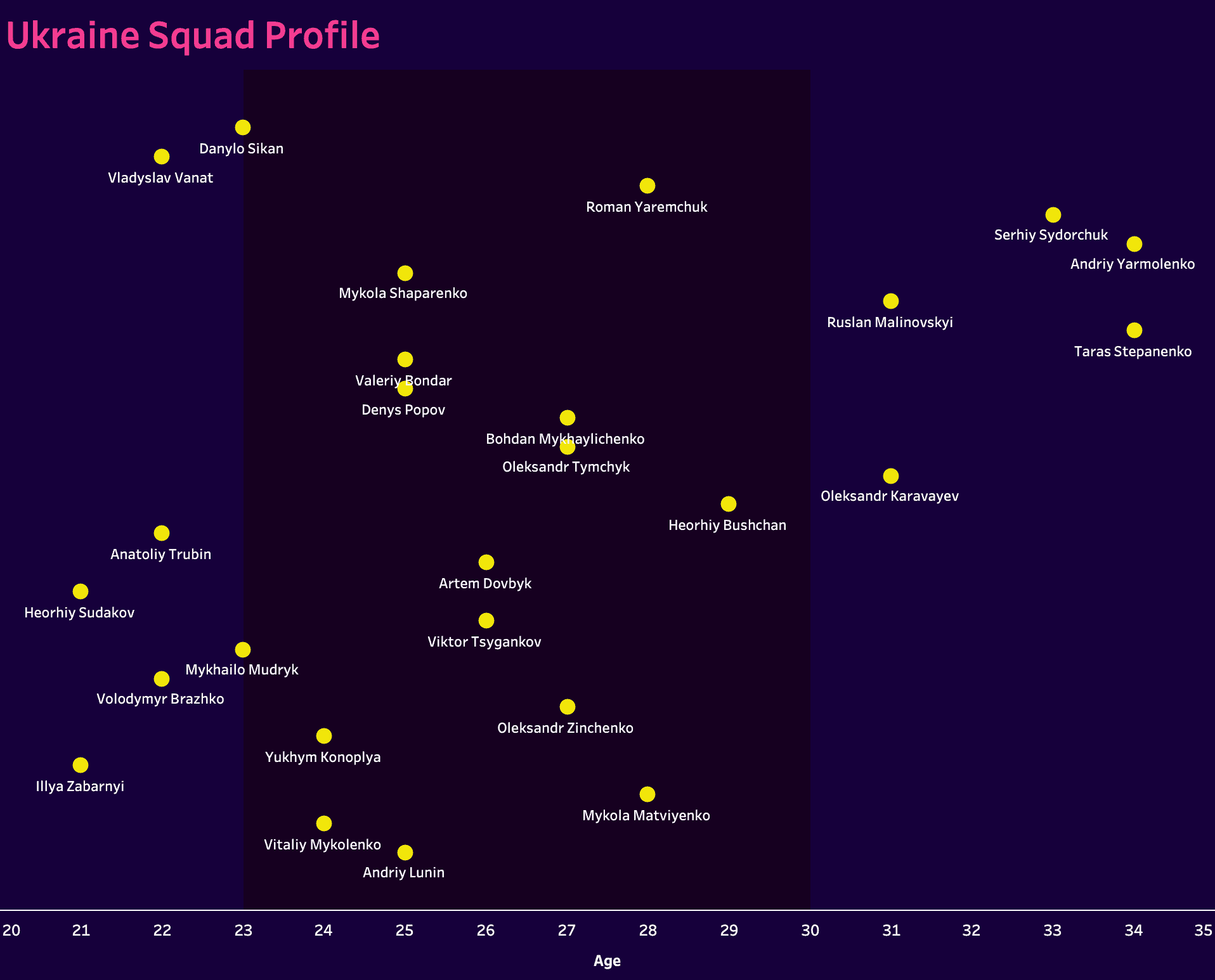
The above graph shows that Ukraine has a good mix of youngsters with more experienced professionals who will likely prove valuable squad players.
What is particularly exciting about the predicted Ukraine starting XI is that plenty of those anticipated to start are in or are approaching their prime, along with the up-and-coming youngsters.
Attacking phase
Ukraine’s approach to matches can vary depending on the opposition, but they are a side that can be comfortable when in possession and will look to build up play from the back.
However, in comparison to other sides who have qualified, their possessional play does rank low, as shown in the radar chart below.
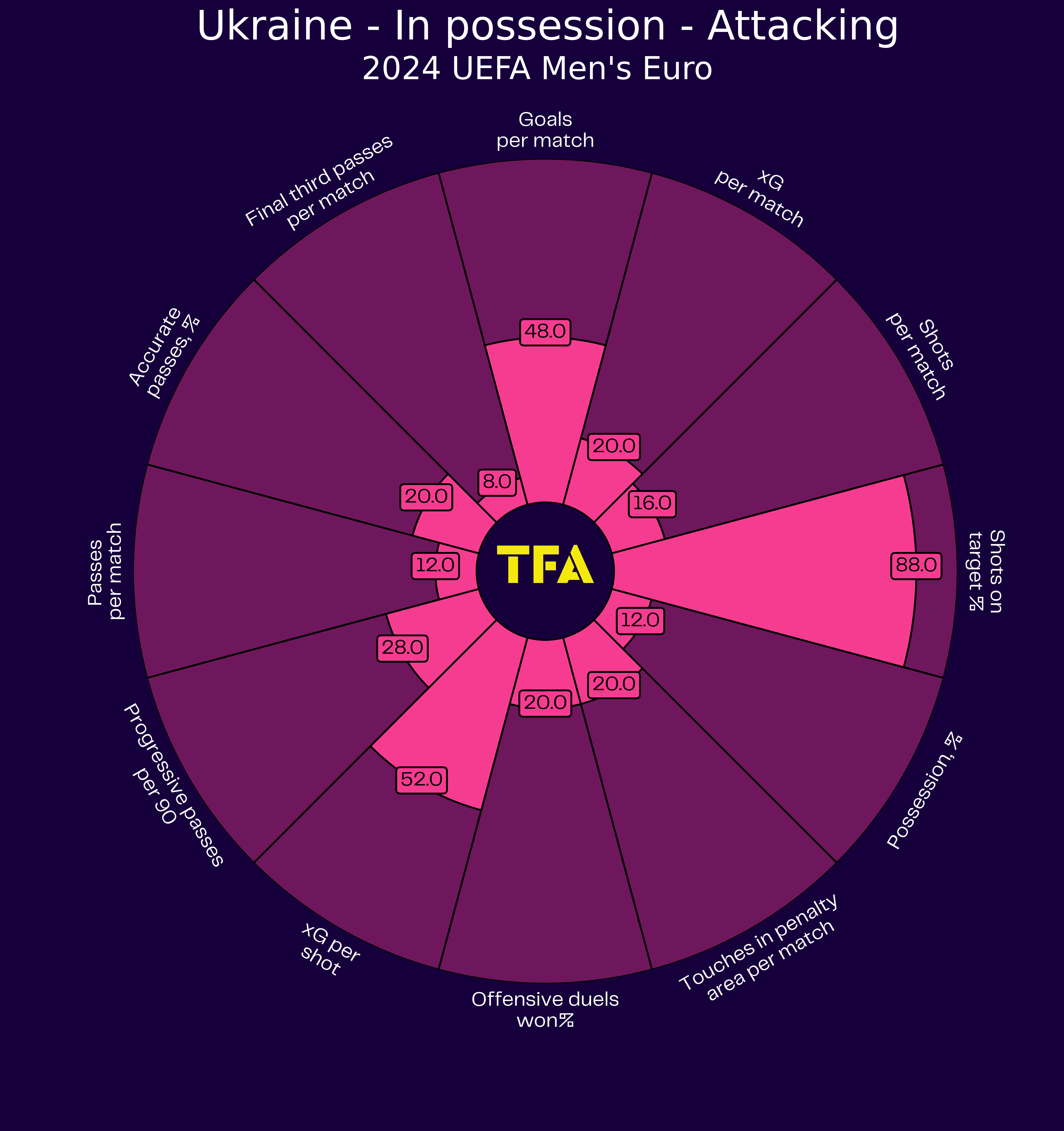
We have already touched upon Zinchenko’s versatility, and the same can be said of his midfield partner, Brazhko, who will often drop deeper to form a back three with the two centre-backs.
This then allows the two full-backs to advance to aid in the attacking phases of play.
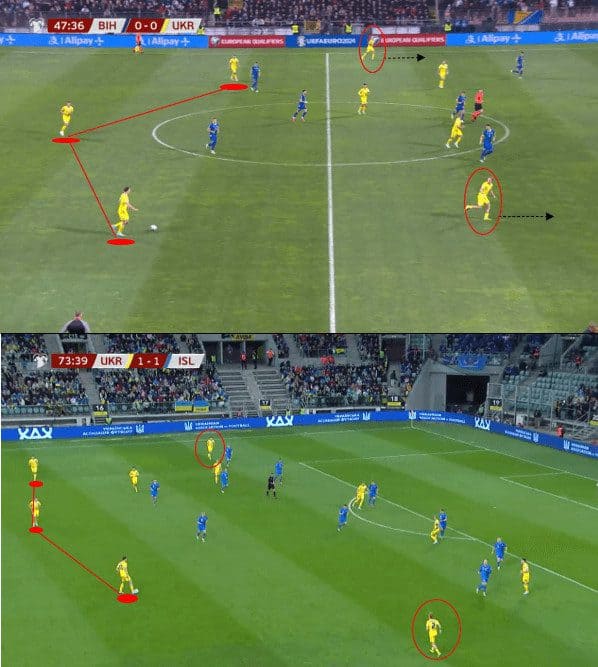
In the above examples, the positioning of Mykolenko and Konoplya gives Ukraine an advantage in the offensive phases.
It facilitates the more advanced midfield and forward options, which drive into the penalty area to get on the end of crosses.
A feature of Ukraine’s attacking play is rotations between the full-backs and the wingers, playing between the opposition centre-back and full-back.
They look to vary the positioning of their crosses with deliveries from the half-spaces or the flanks, which gives a sense of unpredictability to their attacking play.
Ukraine are a side that can dictate the tempo of matches and did so particularly well during qualifying against lesser-ranked nations, such as Bosnia and Iceland, where they had over 60% of the play.
Although Rebrov’s side can be patient with their build-up play, a strong attribute of this Ukraine side is the pace that they possess in their forward line.
Expect this Ukraine side to come alive in the final third as the likes of Mudryk, Sudakov, and Tsygankov look to carry the ball at pace into the box.
The speed of this forward line ensures they will be a threat on the break at these Championships.
Defensive phase
During qualification, it was evident that Ukraine was a well-organised side that only conceded eight goals during the group stage.
Rebrov’s side is strong at intercepting the play, ranking in the top 4% of the qualified nations.
The low PPDA percentile rank in the radar below shows that Rebrov’s side does not adopt a high press.
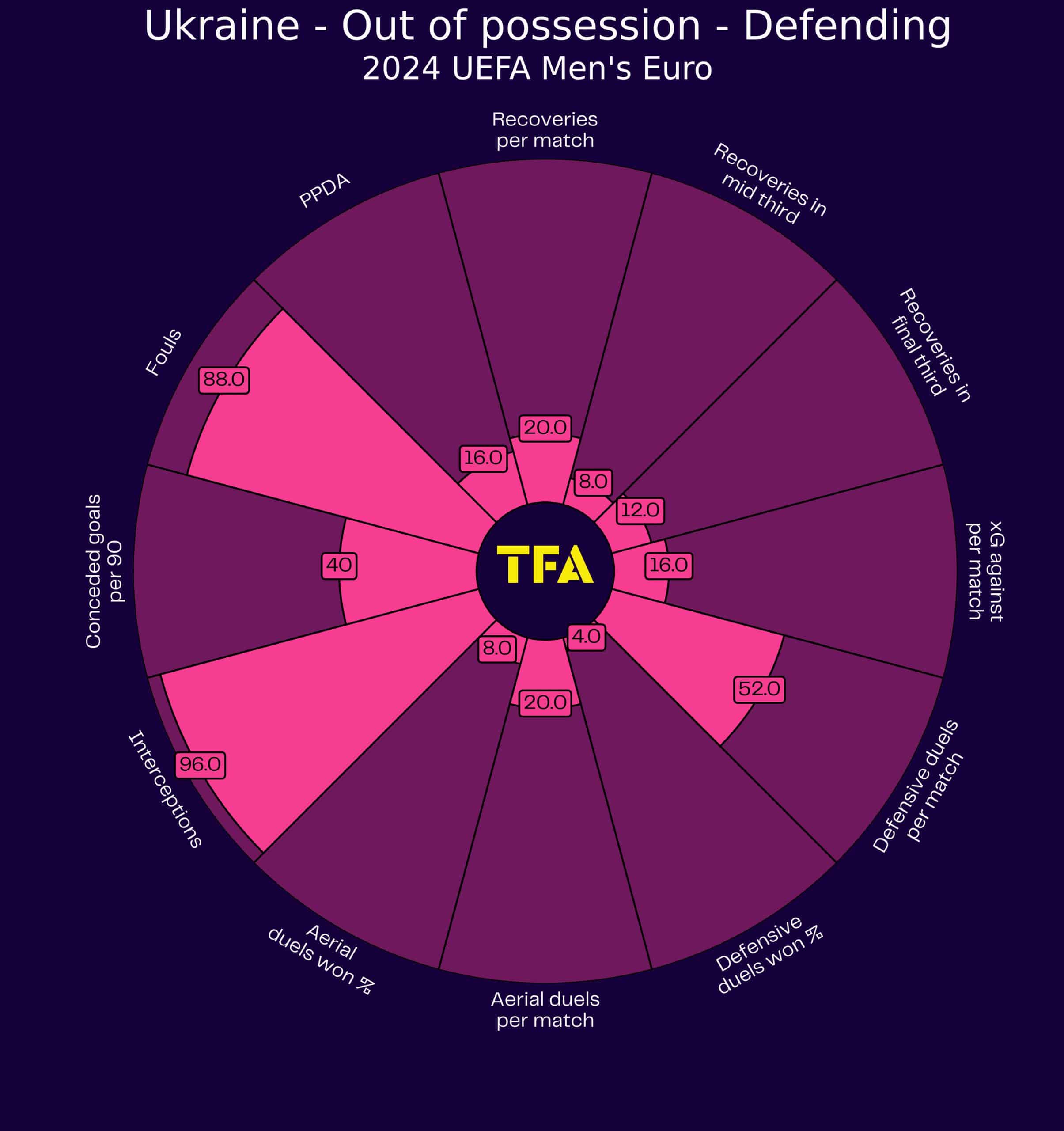
However, Ukraine would be strategic with their press, picking the right moments to commit players in a high press.
The lone striker would often instigate the press, and typically, an advanced midfielder would be tasked with keeping tabs on the opposing defensive midfielder.
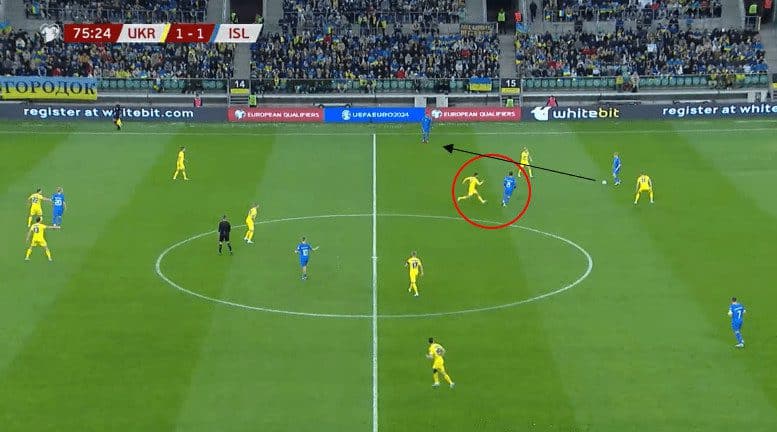
As shown in the above, Sudakov is closing down the central midfield passing option.
As the midfielder is an important figure in transitioning play from the defence to the attack, the strategy that Ukraine adopts effectively forces the play out wide.
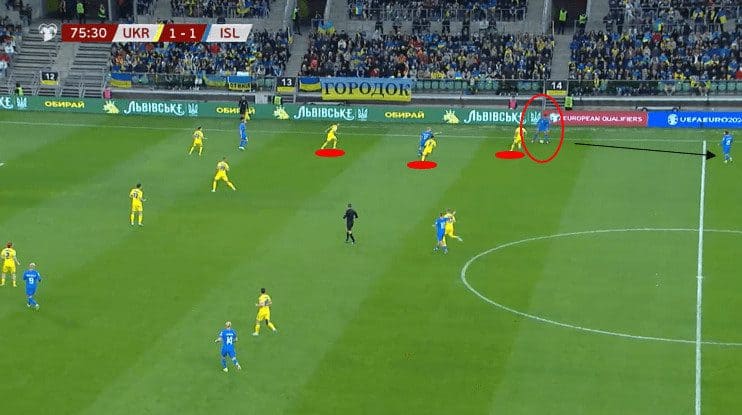
From these wider areas, Ukraine tends to commit more players to a press to overcrowd the opposition and use the touchline as an extra defender.
Whilst this can be useful to stifle the opposition’s build-up play, it can leave Ukraine exposed if the opposition are able to get past the press.
Moreover, the approach to overcrowding opponents can be a bit haphazard at times.
Nevertheless, Ukraine does have a strong defensive unit that is able to adapt during matches depending on how games are unfolding.
For example, despite initially lining up with a back four, Ukraine switched to a back five in the later stages during the play-offs against Bosnia and Iceland when they had a lead to protect.

Not only will Ukraine adapt in-match but they will also adapt their defensive play depending on the opposition.
Throughout qualification for the Euros, they opted for a relatively high defensive line on average but retreated much deeper against tougher opponents such as England.
Therefore, when they are the underdog, don’t be too surprised if Ukraine looks to frustrate their opponents by sitting deeper and inviting the pressure, looking to initiate counterattacks, and use their strong ability to intercept play to their advantage.
Transitions
During qualifying, Ukraine showed strong counterattacking play, and they often used the pace of their forwards in attacking transitions.
However, their approach to counterattacks is not reckless and purely based on pace but intelligent passing.
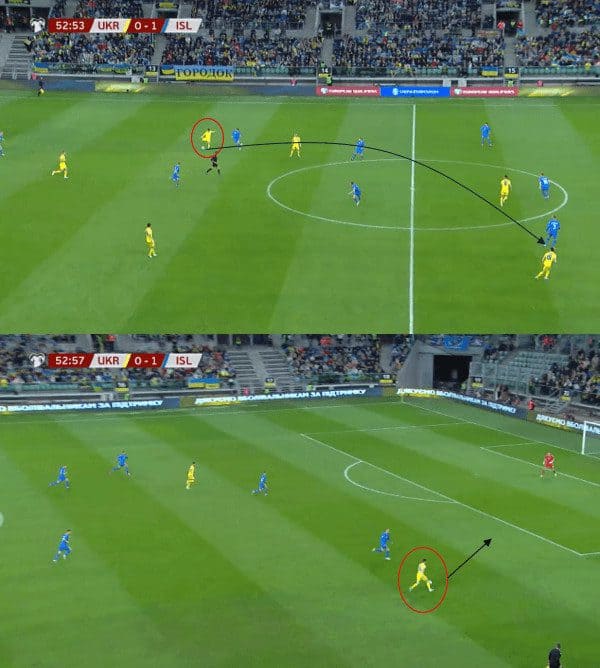
As Sudakov has retrieved possession deep within his own half, he quickly drives forward and switches the play out to Tsygankov, who, in turn, is able to dribble and cut inside around the edge of the box to score.
The attacking instinct to drive forward showcases their direct approach.
Teams will need to be mindful of leaving too much space at the back against this Ukraine side.
The speed of this Ukraine side is also an advantage in their defensive transitions.
As they like to commit overloads in the attacking sense, it can make them vulnerable to opposition counterattacks.
However, the pace through the squad, coupled with a strong awareness of tactical positioning ensure they are effective in recovering when losing possession.
However, as the previous radar indicated, they may struggle against superior opposition to recover possession.
Forwards
At the time of writing, the sole striker, Dovbyk, tops the goal-scoring charts with 20 goals to his name in his debut season in Spain’s top flight.
His strength and speed will be vital in Ukraine’s offensive play, and he will undoubtedly need to transcend his clinical touch at the domestic level onto the international stage to aid in his country’s hopes of tournament progression.
Ukraine does have other options, such as Roman Yaremchuk, and has been known to rotate personnel to lead the lineup.
However, Dovbyk’s strong season makes him the preferred striking option.
Midfielders
One player who is likely to dictate the passing play for Ukraine is Zinchenko.
The Arsenal man excels with his range in passing ability and has completed 70.7% of long passes attempted in the league this campaign – the third highest of the Gunners squad, highlighting his capability to pick out difficult passes.
Whilst Zinchenko’s possessional play is likely to win plaudits, his midfield counterpart will likely fulfil a less glamorous role, getting stuck into tackles.
Brazhko’s defensive positioning will be key in providing cover for the full-backs, and he does rank in the top 25% for defensive positioning compared to other tier-three players this season.
Despite Brazhko’s young age, he has been playing with confidence in the national setup, making it harder for the likes of Malinovskyi to return to the side following an injury that has seen him sidelined since March.
Moreover, Brazhko has proven that he does have a goal in his locker – an added bonus for a defensive midfielder.
Since his big-money move to Chelsea, Mudryk has struggled for consistent form, but he has been an important player for Ukraine, notably scoring the goal of booking their place in Germany.
His speed and ability to carry the ball forward will be instrumental, alongside Sudakov, who has strong attacking positioning and progressive play.
Tsygankov’s strengths also lie in his offensive positional play, as he often looks to cut inside and link up with the sole forward.
Ukraine’s use of high full-backs will, therefore, play to Tsygankov’s strengths, coupled with the fact that he will be able to link up with Girona teammate Dovbyk.
However, Tsygankov, along with the likes of Mudryk, are guilty of taking on shots when the better option would be to play a pass.
This forms part of the reason Ukraine has been guilty of long-range efforts with lower goal expectancies and subsequently is amongst the lowest-scoring nations of those who have qualified.
Better decision-making in the final third will be crucial.
Defenders
From the expected back four of this Ukraine side, we can anticipate that Konoplya and Mykolenko will be pushed up in the offensive stages, looking to provide width in the attacking phases.
However, in addition, both full-back options will be looking to bring solidity to the defensive line.
Mykolenko has been an ever-present for Everton this season until his recent injury, and the Merseyside outfit boasts one of the best defences in England’s top flight.
The Everton left-back has won 62.1% of challenges against dribblers this season, and although commendable, there is room for improvement.
Konoplya’s strengths lie more in his possessional play.
The 24-year-old will have to be alert when up against the pace of the likes of Belgium’s Jérémy Doku.
As Ukraine will look to play a relatively high line at times, a key attribute for their central defensive partnering will be speed.
Luckily for the Eastern Europeans, in Zabarnyi and Matviyenko, this is an important criterion ticked off.
Both defenders possess a strong reading of the game, are comfortable in possession, and have the pace to deal with recoveries if needed.
Both centre-backs look to be progressive, and Matviyenko, in particular, switches the play to stretch the opposition.
The Achilles heel for this defensive partnership, though, is that neither is particularly strong in the air.
Both rank in the bottom 20th percentile compared to their respective tier peers for the percentage of aerial duels won.
It will be an interesting test against Slovakia, who rank in the top 8% for the percentage of aerial duels won of qualified nations.
Key Player
Whilst captain Zinchenko is going to be pivotal in dictating Ukraine’s passing play and Dovbyk the likely talisman, we have identified Sudakov as a critical player for Ukraine this summer.
The Euros could prove to be a big tournament for the 21-year-old midfielder, with rumours that his domestic form has caught the attention of some Premier League sides, including Chelsea and Arsenal.
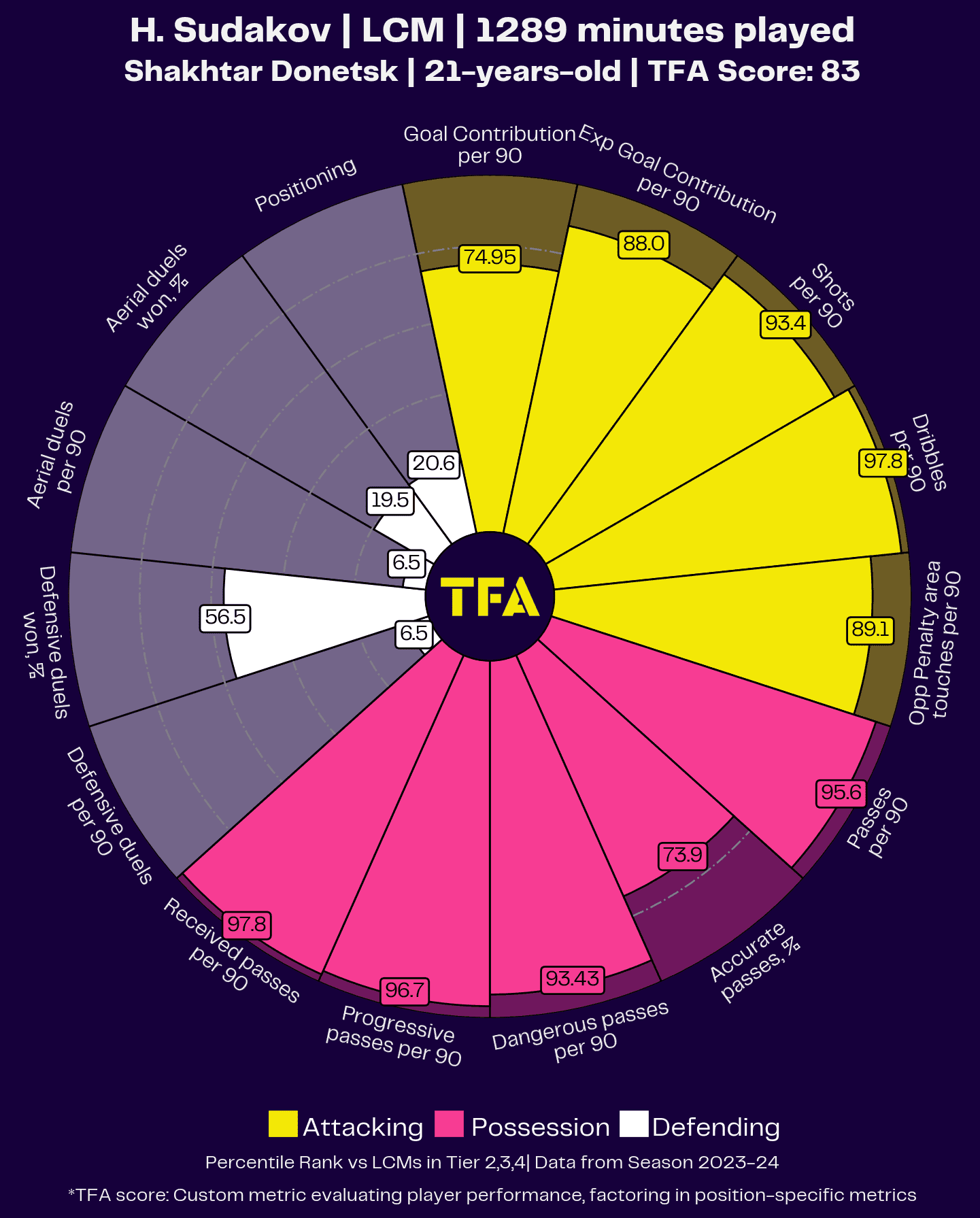
The plot shows Sudakov has ranked in the top percentiles for numerous attacking and possessional attributes for Shakhtar Donetsk this season compared to other tier two, three, and four players.
It will be Sudakov’s ability to pick out passes for the likes of Dovbyk which will prove key in Ukraine asserting dominance in the final third.
The young midfielder’s ability to find pockets of space on the edge of the area will also prove vital if Ukraine is to carve out opportunities against a deep-lying defence.
Sudakov’s main strengths undoubtedly lie in his attacking play, but the previous plot did show that he ranks above the median for percentage of defensive duels won.
Defensive discipline will be needed in Germany by the young midfielder as he is likely to be tasked with closing down the opposition’s defensive midfield.
As we have already shown in this analysis, such pressing will be important in dictating the opposition’s build-up play and, therefore, authority in matches.
Sudakov could prove to be decisive if Ukraine is to progress in this tournament; he is likely to be the architect in their goal-scoring opportunities.
Tournament prediction
Ukraine are not among the favourites for the Euros crown, but there is a lot to like about this squad.
Although Belgium failed to progress from the group stage at the last World Cup, they are still tipped as favourites to top this group.
While Romania and Slovakia automatically qualified for the Euros through the group stage, Ukraine arguably had a more difficult group to negotiate.
Don’t be too surprised if Ukraine can progress to the knockout stages and finish runners-up in Group E, given this talented crop of players.
Regardless of the match outcome, something that will be certain from this Ukraine side this summer is passion and pride in representing their country.
Rebrov’s side will look to ignite some positivity in troubling times.

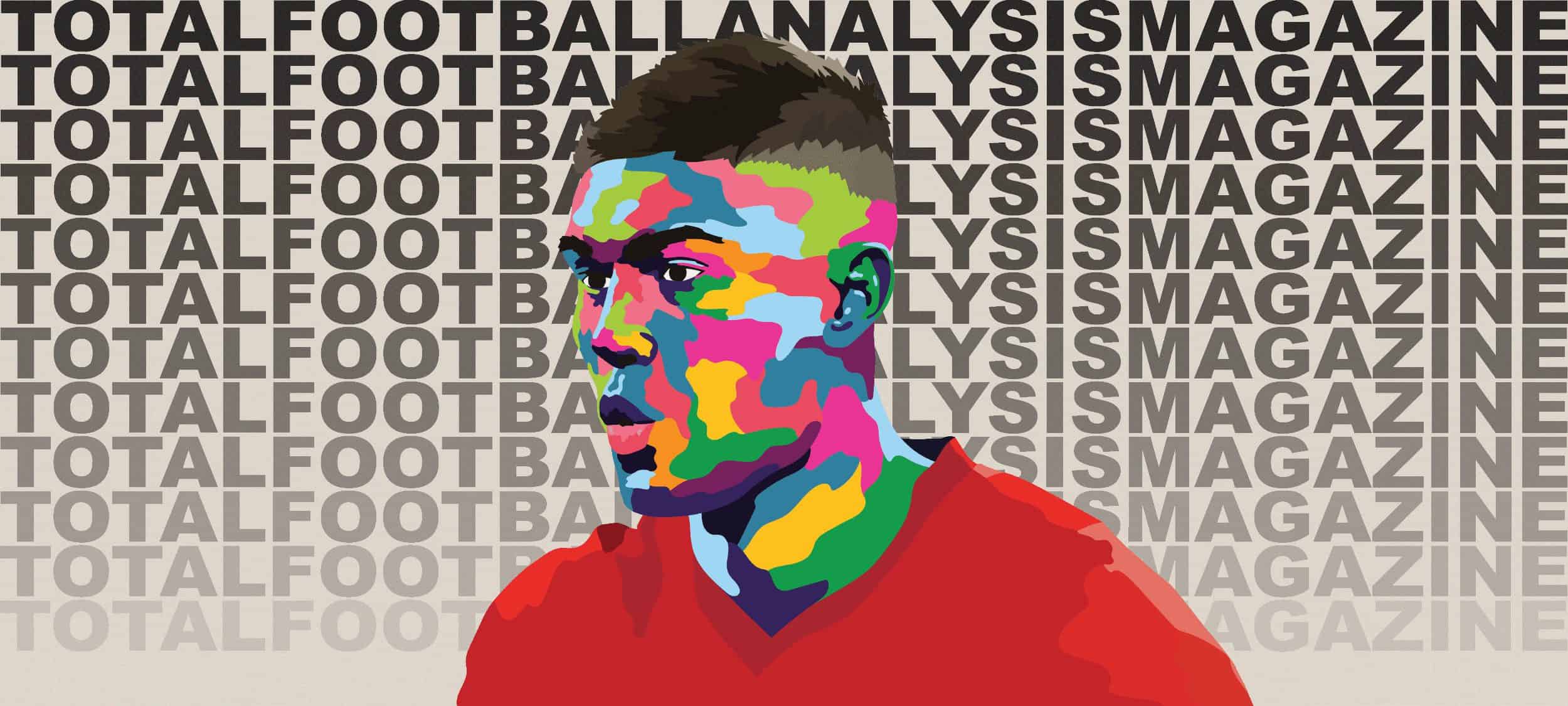




Comments